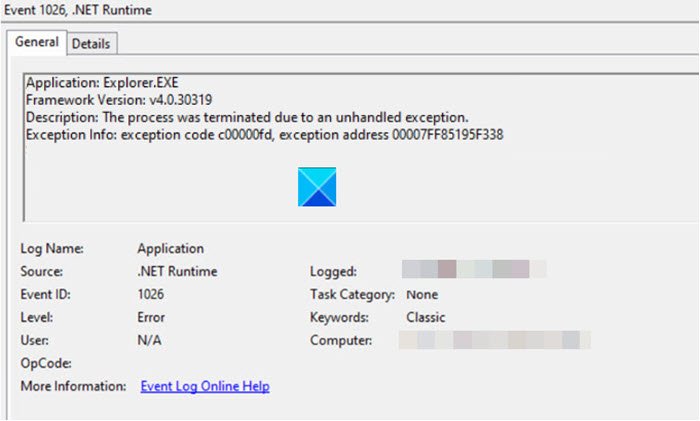Fix .NET Runtime Error 1026
Event 1026 indicates that the problem lies with the application itself and Runtime error 1026 associated with .NET Framework mainly occurs when the framework fails or crashes while running as it was not programmed to handle properly (an “exception”).To fix this, you can follow any of the methods given below! Let’s explore the listed methods in a bit of detail!
1] Disable and re-enable the .NET framework
It has been observed in many cases, the reason you keep getting this error message is that Windows 10 comes with .NET Framework 4.7 and 4.5 preinstalled. However, some of the applications might require an earlier iteration of the framework like 2.0, 3.5, or 4.0. You can try the following method and check if it solves your problem.
Type ‘Turn Windows features on or off‘ in the Windows search bar and press Enter.When the Windows Features window opens, click on the ‘+’ icon, adjacent to .NET Framework 4.7 Advance Services to expand its menu.Uncheck all the options listed under it.Uninstall the framework and restart your PC.Next, reinstall the .NET Framework, go back to the Windows Features window, and click on the ‘+’ icon, adjacent to .NET Framework 4.7 Advance Services.Now, check all the options back and restart the computer again.
Run the application/program to check if the problem is resolved. Read: How to check .NET Framework version installed.
2] Re-install Runtime Libraries
It’s likely that you are seeing the error because of an update, like the MS Visual C++ package which might not be installed properly or completely. To fix it, uninstall the current package and install a fresh copy.
Go to Programs and Features, find and highlight the Microsoft Visual C++ Redistributable Package.Right-click it and choose the Uninstall option.Reboot your computer.
Download the latest redistributable package from Microsoft then install it. Read: Troubleshoot .NET Framework Installation Issues.
3] Troubleshoot in a Clean Boot State
In Windows, many different drivers, settings, and programs are interacting or communicating with each other simultaneously. This varied environment may lead to software conflicts that can manifest in several ways, as .NET Runtime Error 1026. Performing a clean boot may help in pinpointing the conflict and resolving it. It is important to note that the same event can be recorded for a wide variety of applications and thus, have multiple solutions. For instance, the ‘System.Net.HttpListenerException’, may be related to a problem with an HTTP request, caused by the local TCP/IP configuration or a network connection issue and thus have some different solutions. If you are aware of any different solutions than the ones described above, share them with us in the comments section below.

